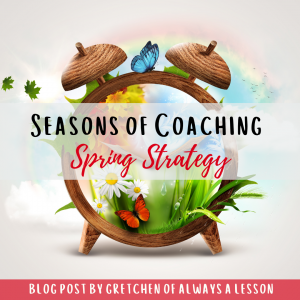Seasons of Coaching Blog Series: Spring Strategy
Teacher leaders need a coaching strategy when working with teachers in the classroom. For their support to grow the instructional skill level of a teacher, a strategy should be in place first. This ensures alignment between state/district goals, school curriculum, and teacher needs and wants.
 Being responsive with a coaching strategy means you cannot have one strict way to support teachers. You have to reflect what is happening at each season of the school year. Grab the “Creating a Coaching Strategy Checklist” to help you prepare to implement the ideas below.
Being responsive with a coaching strategy means you cannot have one strict way to support teachers. You have to reflect what is happening at each season of the school year. Grab the “Creating a Coaching Strategy Checklist” to help you prepare to implement the ideas below.
The previous posts in the series described the fall coaching strategy (read it here) that focused on foundational skill building and the winter coaching strategy (read it here) that focused on more complex instructional techniques.
Following the spring season that brings growth and rebirth in the outdoor environment, the same is happening inside school buildings. The following stages will keep your coaching strategy relevant and productive.
Step 1: Revisit Data
Teachers need to revisit data to decide how well their instruction in the first semester was supporting the academic development of students. Teacher leaders can have data dive chats with teachers, focusing on specific skills, students, and/or assessments. This will bring clarity to what teachers should work on in small groups or 1:1 with students. It also provides a clue to teacher leaders how they need to continue to support the development of that teacher.
Step 2: Acknowledge and Celebrate Growth
Teachers need to celebrate their growth. Teacher leaders can call out what specific instructional techniques have improved, how, and why it’s had a positive impact on student learning. Hearing this specific feedback both encourages and motivates the teacher to keep applying what they are learning daily. Handing out awards to teachers is a great way to do this!
Step 3: Make Way for Future Growth
Just as we till the soil to make way for new growth, we have to prepare for future growth in our own skillsets. We do this by applying all that we have learned and adding in new strategies before the spring testing fever hits. We don’t want teachers to assume that just because they’ve mastered fall and winter skills, that they are done learning. The spring will challenge teachers to take risks and try new facilitative learning strategies as students begin to spiral through old content to solidify understanding prior to state testing. Areas like going beyond the curriculum, incorporating more student ownership and accountability, as well as ensuring continuous collaboration will strengthen the learning in the spring season.
Step 4: Close Out the Year
With all the work that has been accomplished during the school year, it’s time to reflect on what worked and what didn’t. Teacher leaders should think about what coaching strategy moves they want to keep, pause and/or change. This is also a great time to get feedback from teachers on how well they felt supported in meeting their personal and professional goals during the partnership.
NEXT STEPS:
- Read the other blog posts in this series: Fall, Winter, and Summer.
- Want help closing out the school year while still employing effective seasonal coaching strategies? Grab the printables for each step mentioned above in the Coaching End of the Year Resources.
- If you’re looking for guidance and feedback while you begin to implement your seasonal coaching strategy, join the Teacher Leader Mastermind! It’s a community of coaches nationwide that meet virtually to chat through obstacles, celebrate wins, and cheer each other on as we grow our leadership skills.
GO BE GREAT!


 Get Edu-Tips, Freebies and grab your FREE Study Guide for Gretchen’s New Book!
Get Edu-Tips, Freebies and grab your FREE Study Guide for Gretchen’s New Book!